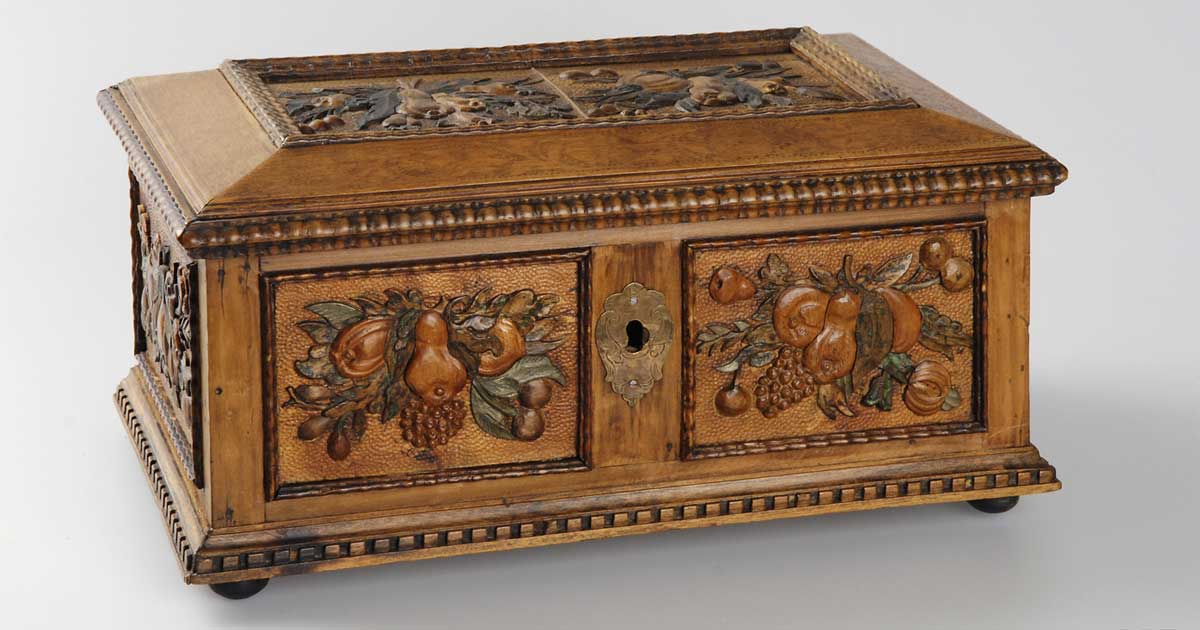The History of Jewelry Boxes
- By Laryssa Wirstiuk
- Jul 28, 2021

As lovers of jewelry, especially pearl jewelry, we take pride in caring for our favorite pieces, so they can last a lifetime and even be enjoyed by future generations. Having a safe place to store jewelry is essential for maintaining its original condition. For many people, jewelry storage methods are based on personal preference, but jewelry boxes have an undeniable charm, making them one of the most common ways to store treasured items.
Throughout history and for many centuries, jewelry lovers have also prioritized the storage of their favorite pieces. However, the reasons for storing jewelry have changed and evolved over time. For example, today someone might put jewelry in a box to keep it from tarnishing or getting damaged, whereas in ancient times, jewelry storage was primarily for safekeeping and less about sustaining the condition of the jewelry.
Over the years, jewelry boxes have changed in shape and size, and they've been built from many different types of materials. In the past, jewelry boxes were even referred to as "jewelry caskets" and resembled small treasure chests. But one thing hasn't changed: no matter what the era, intricately-designed jewelry boxes have contained the beautiful pieces within them. Continue reading this post to learn more about the history of jewelry boxes.
Ancient Egypt
Though it’s hard to pinpoint who first invented jewelry boxes, history has shown that these unique boxes were a functional tool used around 5000 BC and possibly even earlier. In Ancient Egypt, jewelry caskets were commonly used by men and women regardless of their social status because jewelry had a spiritual aspect that held high importance. The Egyptians even believed that certain types of jewelry would benefit them in the afterlife.
They had developed advanced methods for handcrafting boxes and wooden chests that would be useful in storing jewelry and other meaningful items. These storage boxes were a necessity for every Egyptian, rich or poor. For the upper class, the jewelry boxes were beautifully designed with incredible carving, metalwork, in-laid jewels, and gold and silver gilding. Gold and other valuable items were stored in jewelry caskets and buried with Pharaohs. Lower-class Egyptians would have used decorated reed wooden boxes or chests to store their items.
16th Century
During the 16th century, owning jewelry was a rare luxury. Royals like Henry Tudor knew how to lure potential love interests with his great taste in gift giving. Jewelry artisans fulfilled the king’s desires, with attention to crafting the most beautiful jewelry with an intricately designed storage box.
Jewelry boxes were beautifully crafted and encrusted with gems, often making them even more valuable than the jewelry that was held inside. Artisans spent a lot of time and effort focusing on intricate details and beautiful inlays to craft these boxes to perfection. Each box was made one at a time in materials like silver, gold, and ivory and lined with velvet or leather. Not only were these boxes just as beautiful as the pieces they held, but the airtight containers also served a practical function for protecting treasured items from dirt and grime.
18th Century
The 18th century saw a spike in the production of trinket boxes. Trinket boxes were embellished on the top in many different designs decorated with flowers, birds, and other delicate motifs and had a hollow space when opened. These boxes were much smaller than jewelry boxes, yet still the perfect size to keep jewels and other trinkets. Trinket boxes have been made in a variety of different materials: gold, iron, wood, stone, porcelain, and paper mache. The spread of porcelain ware, enameling, and art metal gave rise to the popularity of trinket boxes, and they became a necessary item amongst nobles.
In the late 18th century, musical jewelry boxes re-emerged. The first examples of musical boxes were seen in 1502. Charles Reuge, a swiss watchmaker, is a notable craftsman who evolved the musical box. He started crafting musical pocket watches that played enchanting melodies inspired by singing birds in the Swiss mountains and later crafted musical jewelry boxes. These boxes contained tiny drums, ringing bells, and metal combs that worked together to create melodious sounds when the box opened or if the screw was wound.
Industrial Revolution in the US
The United States economy progressed from manual and farm labor to more industrialized based labor in the latter half of the 18th century. The Industrial Revolution saw improvements in technology and the foundation of manufacturing. Because of the overall improvement in production, beautiful jewelry boxes suddenly became an attainable item that almost anyone could afford. Jewelry boxes, which were once a treasured item only the royals and aristocrats could acquire, began to lose their value because of mass production. Fine jewelry became more affordable after the industrial revolution, and the size of jewelry boxes became smaller, to accommodate more middle class families.
Art Nouveau - 20th Century
Art Nouveau had a major impact on jewelry boxes and marked a transition in design from the 19th century to the 20th century. Art Nouveau flourished throughout Europe and the United States and is characterized by its use of sleek lines and emphasis on purpose over form. This new way of looking at art symbolized freedom and signified a return to nature. Jewelry boxes were beautifully painted with natural themes and floral motifs for a lighter and more feminine look.
21st Century
In the 21st century, some daring luxury goods makers chose to push the boundaries of jewelry box craftsmanship. The luxury goods company Mouwad introduced the ‘Flower of Eternity Jewellery Coffer,’ a jewelry box crafted using 18K gold and sterling silver, and decorated with 542.39 carats of white and yellow diamonds, 293.42 carats of white and pink sapphires, 20.06 carats of rubies, and 1,799.95 carats of lapis lazuli. With a value of $3.5million, this breathtaking jewelry box was named the world’s most valuable jewelry box by the Guinness World Records in 2016.
Jewelry Boxes in Museums
Some jewelry boxes have even been deemed impressive enough by art historians to find their way into the permanent collections of museums. Here are some examples.
Egyptian jewelry box at the Met
Here's an example of a Late Antique, Egyptian jewelry box ca. 4th-6th century. The wood and bone box was decorated using two different techniques, carving and wax filling, to produce images of male nudes and female dancers. This box would most likely have been used by a wealthy female to store jewels and other precious items.
French jewelry casket
Here's an example of a French-made jewelry casket, ca. 1575-1585. This jewelry casket was crafted in materials such as gold-tooled leather, gilded metal mounts, and silk satin lining.
French jewelry box at the Met
This is an example of a French jewelry box ca. 1875 crafted in gold and enamel by Lucien Falize. Falize was one of the first artists to apply natural or plant-like forms to jewelry design, and the box foreshadows the Art Nouveau style.
American jewelry box at the National Museum of American History
This Art Deco style box was made by the Celluloid Manufacturing Company in 1929. The jewelry box is crafted with orange celluloid, and the lid features a tulip motif.
Add-A-Pearl Jewelry Boxes
Though intended to store and protect your precious gems and jewelry pieces, the most beautiful thing contained within jewelry boxes are your meaningful memories. As keepers of history, jewelry boxes are timeless gifts that keep treasured items protected and organized. These decorative objects make a great gift for just about any occasion. At Add-A-Pearl, you can choose from the Ballet Slippers Musical Jewelry Box or the Silver Plated Heart Jewelry Box, both perfect for storing treasures.
The Ballet Slippers Box is decorated in floral and ballet motifs and has plenty of storage for necklaces. The best part is that it plays music! On the other hand, the Silver Plated Heart Jewelry Box is polished and timeless, perfect for any age.
Shopping for the Perfect Jewelry Box
When shopping for the perfect jewelry box, you should consider a few factors. First, look at your jewelry and take a quick inventory of all your pieces. For someone who mostly has rings, you'll want a jewelry box that has plenty of slots to hold your rings. A jewelry box with roomy drawers would be perfect for someone looking to store their bracelets. Necklaces can be laid flat in a spacious drawer or hung in a jewelry armoire. Having a different space for each piece of jewelry will prevent it from getting tarnished or tangled.
While you can find jewelry boxes crafted in a variety of materials, wooden jewelry boxes are sure to keep your items safe and protected. Wood is durable, protective, and attractive. The lining of a jewelry box is another factor to consider. The lining should be lint free and soft to the touch to prevent pieces from getting scratched. The lining should never feel harsh. For extra care, you can choose to store delicate gemstones in jewelry bags before placing them in a jewelry box.
Finding a jewelry box takes time, and you ultimately want to choose one that delights you. A good jewelry box will keep your favorite pieces safe for a lifetime.
Throughout history, we’ve seen that jewelry boxes have highly desirable items that are both aesthetically pleasing and functional. Who can resist a charming jewelry box and not want to know what’s held inside? What's your favorite way to store your treasured pieces?
Sources
http://www.sparkle.com/jewell-post/#.YPhhfi2ZOCQ
http://beadsguru.blogspot.com/2014/11/the-evolution-of-modern-jewelry-box.html
https://www.acsilver.co.uk/shop/pc/what-is-a-jewellery-box-history-of-d119.htm
https://www.jckonline.com/editorial-article/history-of-the-jewelry-box/













